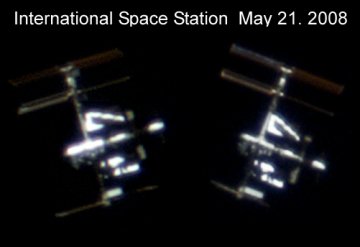| FLYBY ALERT! Space shuttle Discovery launches on May 31st. Get your flyby alerts from Space Weather PHONE | | | SPACE STATION TOILET: Houston, we have a problem. The main toilet onboard the International Space Station is broken. "[It] works for solid waste disposal, but requires additional steps for liquid waste," says Kirk Shireman, deputy ISS program manager at NASA. The procedure for liquid waste "takes two crew members and 10 minutes of maintenance after three flushes." Fortunately, space shuttle Discovery is set to launch this Saturday with spare parts needed to restore normal operations: full story. SPACE STATION MOVIE--THE SEQUEL: A new movie of the ISS by German amateur astronomer Dirk Ewers seemingly reveals every detail on the sprawling station down to the malfunctioning water closet. Well, not quite that much detail, but the video is still impressive. Click on the image to play: 
Click to play a 2 MB movie
"This was the view through my 5-inch refracting telescope," says Ewers. "Seeing was good" on May 21st when the brilliantly shining space station passed almost directly over his observatory in Hofgeismar, Germany. "I worked on the video for nearly 12 hours and I believe it reaches the theoretical resolution of my 5-inch optics." No telescope is required to enjoy the ISS, however. The 240-ft wide spacecraft is often brighter than Venus and easy to see with the unaided eye even from light-polluted cities. The trick is knowing when to look. more images: from Ralf Vandebergh of the Netherlands; from P-M Hedén of Vallentuna, Sweden; from Stanislaw Rokita of Torun, Poland; from John C McConnell of Maghaberry Northern Ireland BISHOP'S RING: This week, sky watchers across Euope are noticing a daily pale-blue aureole (fuzzy ring of light) surrounding the sun. "It lasted for hours as a cloud of dust from the Sahara desert drifted overhead," says Tamas Ladanyi of Veszprem, Hungary, who took this picture on May 28th using his Canon 300D: 
This phenomenon is called a Bishop's Ring and it is caused, in this case, by wind-blown clouds of dust from the Sahara desert wafting over Europe. "A Bishop's Ring is a large corona made by volcanic dust or other small particles such as fine Sahara sand," explains atmospheric optics expert Les Cowley. "Look out for a huge bluish aureole around the sun edged by pastel yellows and reds - that’s a Bishop's Ring. How can dust make a corona? Corona makers do not need to be transparent because light scattered by the particle edges make the diffraction pattern. Pollen, telescopes and even pond algae make them. Look for them everywhere!" more images: from Gernot Lausen of Fleckeby, Schleswig- Holstein, Germany; from Martin Popek of Nýdek, Czech Republic; from Tomas Trzicky of Prague, Czech Republic;
May 2008 Aurora Gallery
[Aurora Alerts] [Night-sky Cameras] | 
